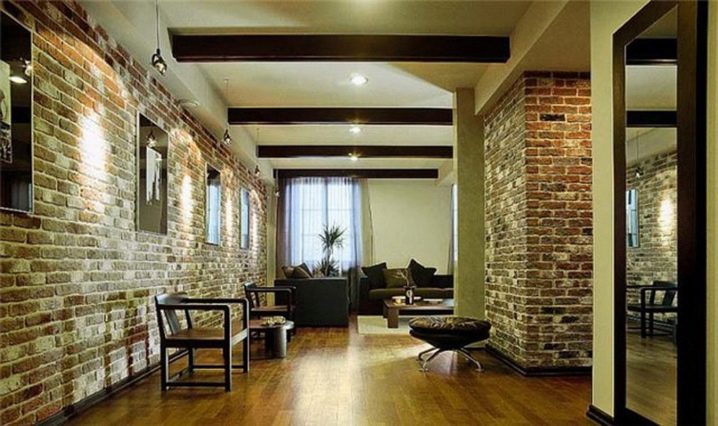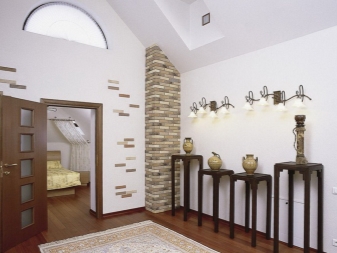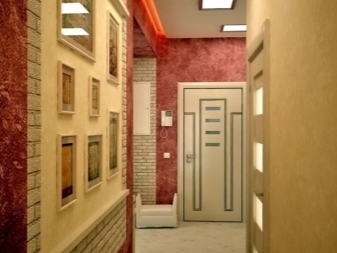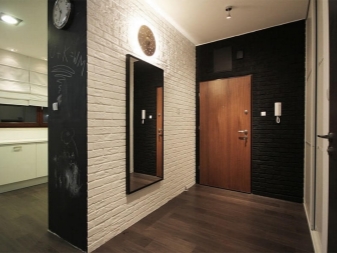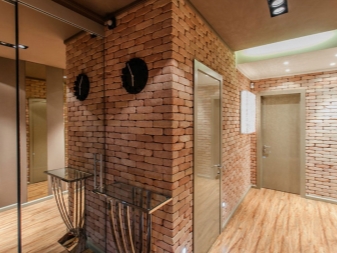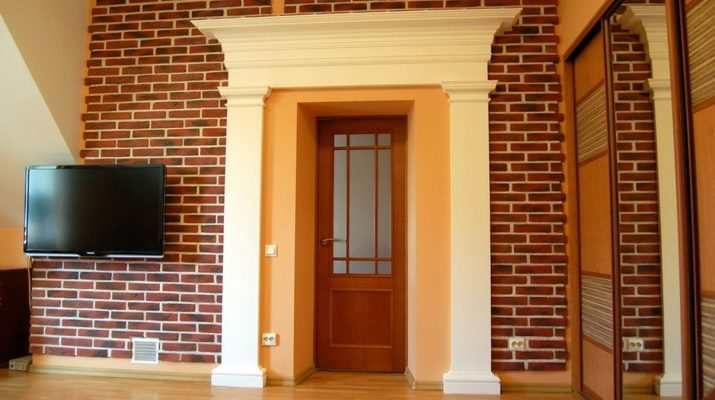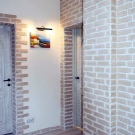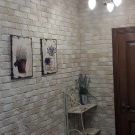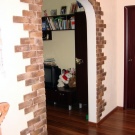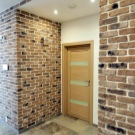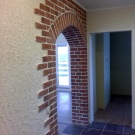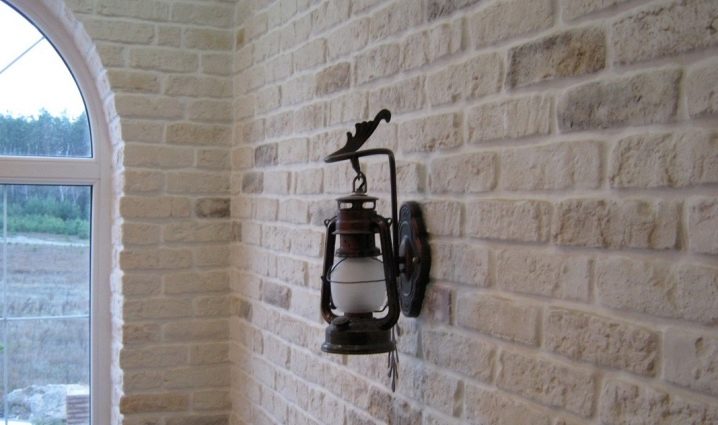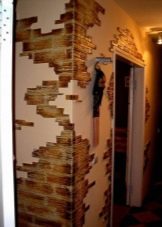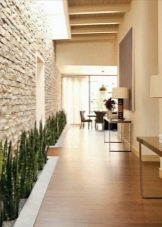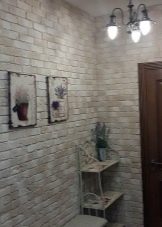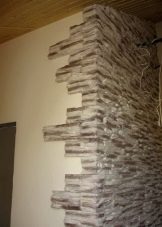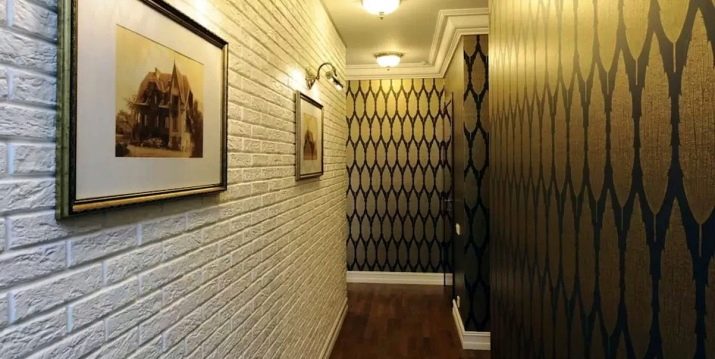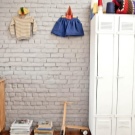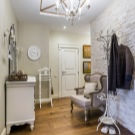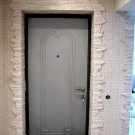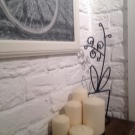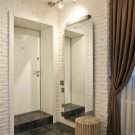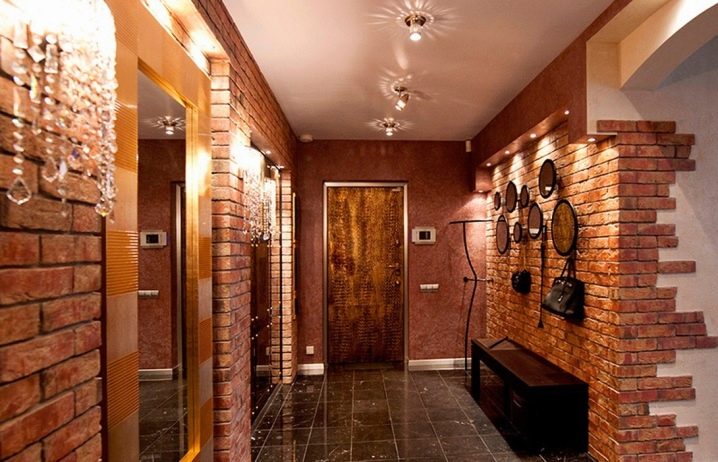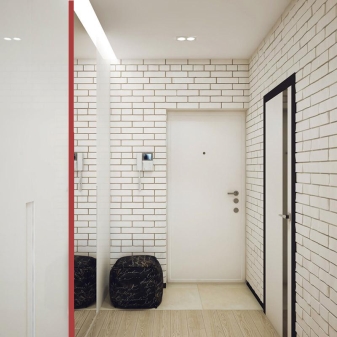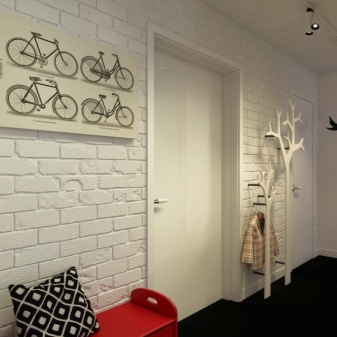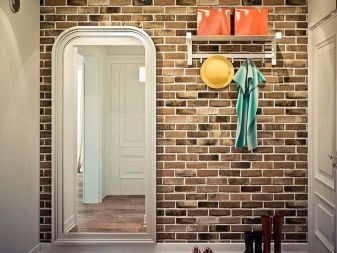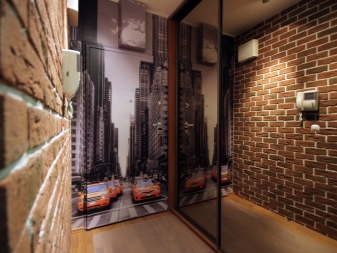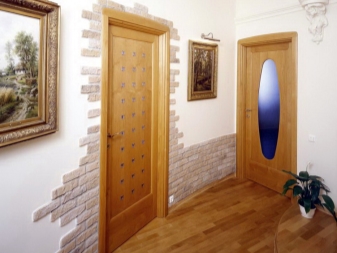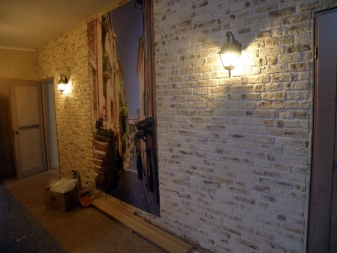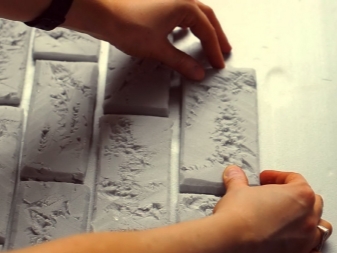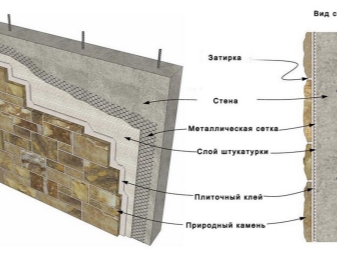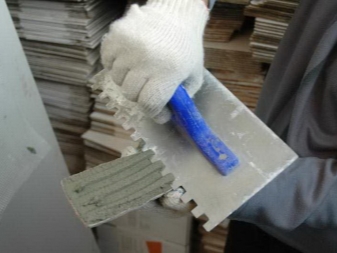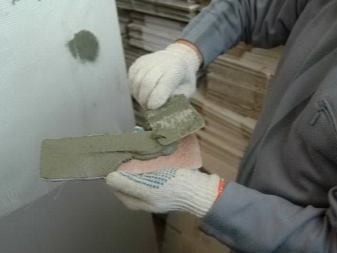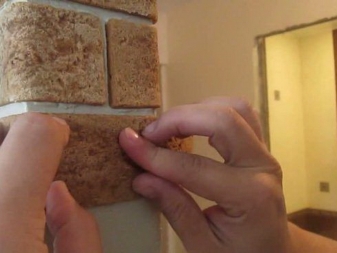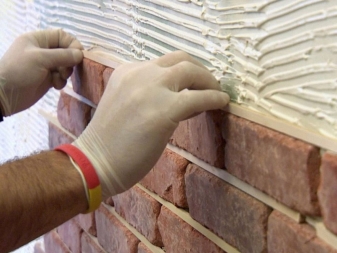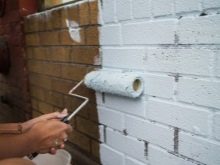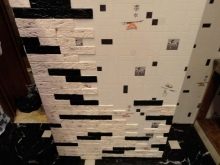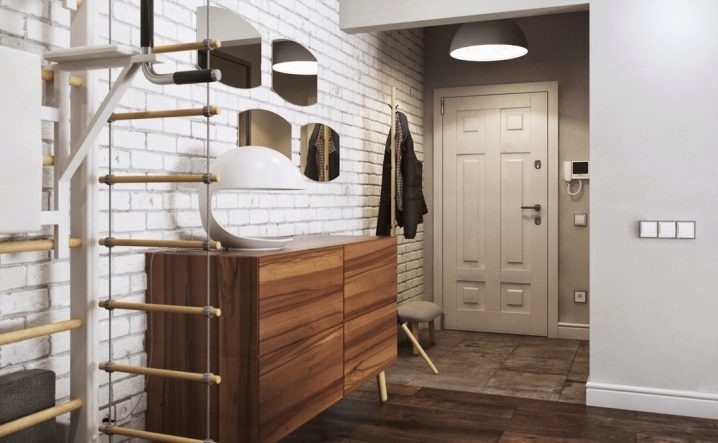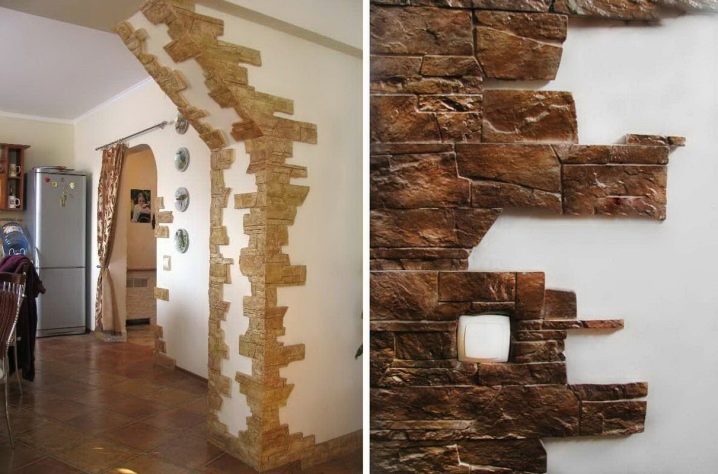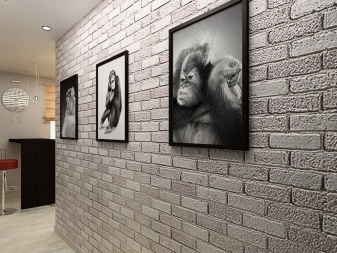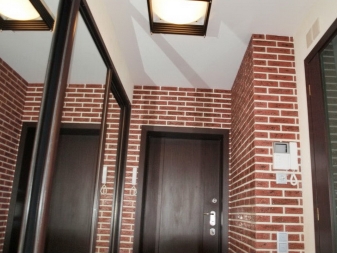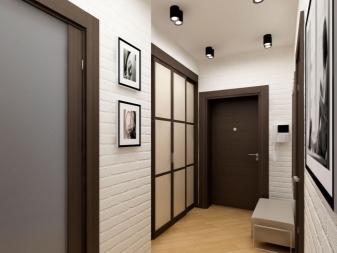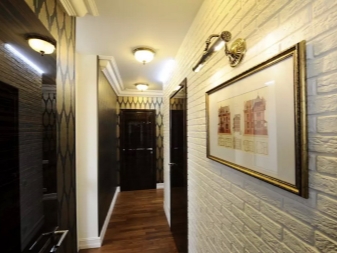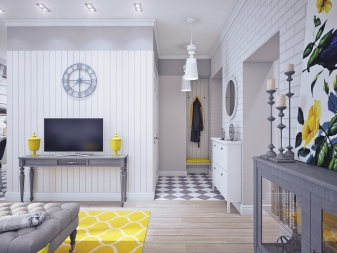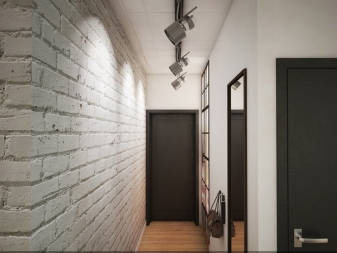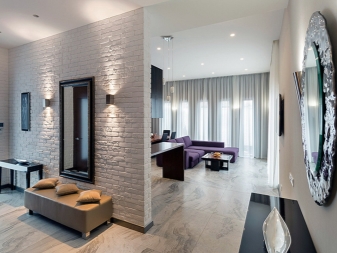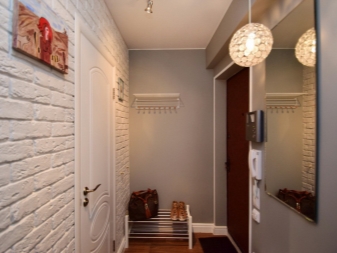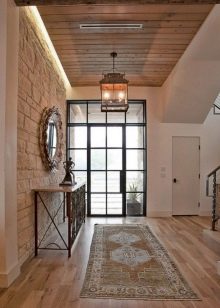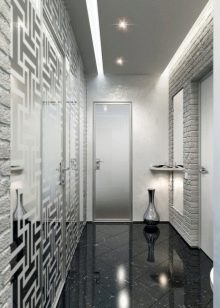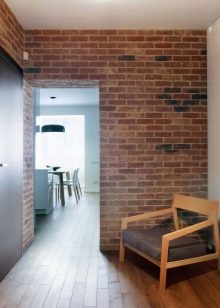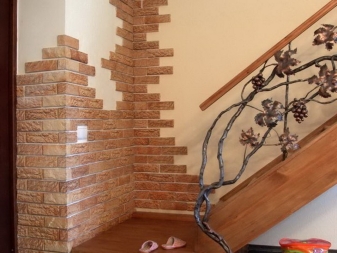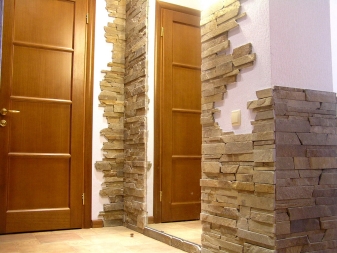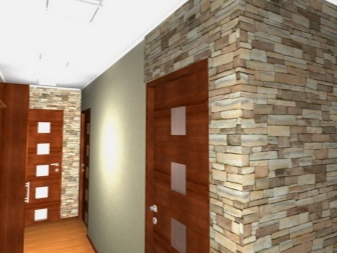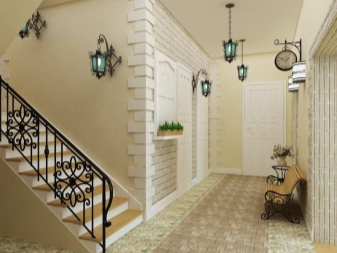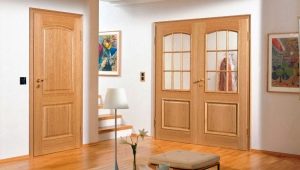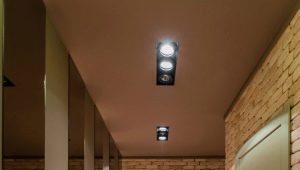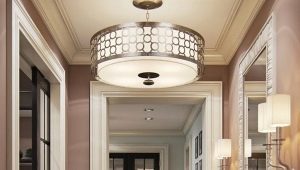Wall decoration in the corridor with decorative brick
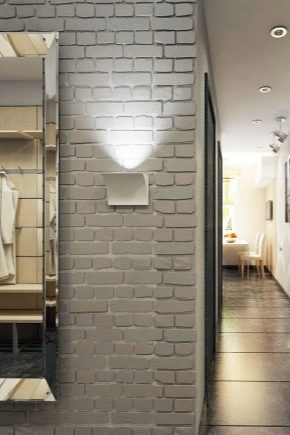
Decorative brick is quite popular type of finishing materials. Initially, it was used to finish the facades of buildings. Having gained popularity, this material has become actively used in the design of interior spaces. Today it is the most sought-after type of decoration of the hallways, corridors and foyer. Wall decoration in the corridor with decorative brick has its strengths and weaknesses.
Advantages and disadvantages
Decorative brick is a beautiful and fashionable finishing material with the following advantages:
- low weight allows you to brick large enough surfaces without fear of undue stress on the foundation of the building;
- high strength material allows the use of decorative bricks in high traffic areas;
- easy care and resistance to mechanical stress enable the use of such finishes in apartments where there are pets;
- there is the possibility of its fragmentary replacement in case of damage to one element of the masonry (there is no need to change the entire covering of the wall entirely);
- wide price rangeA large model range with a huge variety of colors and design allows you to choose a material for every taste and budget.
The disadvantage of decorative bricks is the fragility of certain types, which requires careful handling when laying.
Kinds
Among the large range of products offered, it is important to consider the following point: along with decorative bricks, wall tiles are used to mimic the appearance of brickwork when facing walls. She is called clinker and is a popular analogue of decorative bricks. Its advantage is that it weighs much less and has a smaller thickness. This allows for finishing not to reduce the effective area of the corridor.The brick tile costs much more expensively than a usual decorative brick and differs in the increased operational qualities. It is dense and durable, comes in a wide color palette and has a smooth surface.
Thanks to its heat resistance, tiles can be used near fireplaces and stoves. It is made of baked clay, covered on top with a layer of glaze. Its thickness is from one to three centimeters. This material is used in all modern styles. This design of the corridor wall in the loft and hi-tech directions is particularly relevant, being an imitation of stone.
The second type of finishing material - decorative cement brick. It is made by hand, its components are sand and clay. The technical parameters of the raw materials are similar to those of ordinary bricks, although the coating is brittle and requires careful handling during installation and operation. The surface of this material is rough and embossed. When cleaning a wall decorated with a decorative cement brick, it is impossible to over-wet the surface or use chemical means.The material is environmentally safe and suitable for use in the design of the living room corridor.
The downside of cement coatings is a large amount of dust when cutting and the need to comply with the humidity regime. This figure should not exceed 50 percent. In the manufacture of granite, marble and a combination of quartzite with polymer clay are often used: this allows to improve the performance properties of the material, gives the building blocks increased strength and durability.
The third type is artificial gypsum stone. This material is the most inexpensive type of decorative decoration of hallways and corridors, it is lightweight and can be installed on plasterboard walls. Gypsum bricks are quite fragile and do not tolerate conditions of high humidity (with excessive moisture, the bricks can be deformed and destroyed). Upon completion of installation, it is covered with a special water-repellent lacquer: this increases the wear resistance of the coating and allows the material to be used in the design of the walls of hallways and corridors.
Colors
To obtain a variety of shades in the raw materials from which the brick is made, add dyes.This technique ensures the production of products in a wide color spectrum, taking into account the possibility of selecting finishes in any shade (the color of the interior, furniture, in soft contrast).
The color range of bricks affects the visualization of the room. For example, for small hallways and narrow corridors, white finish with a glossy surface is well suited. This allows you to visually enlarge the room and bring freshness into the interior.
When buying bricks, slightly differing in the color of the color, there is a technology of coating with a special compound, making the differences in color almost imperceptible. This technique allows you to mask minor chipped bricks, although new defects of the fragments give the difference between the outer and inner color of the material.
Finish
Making out the hallway decorative brick, you need to determine the area of the surface to be decorated. Then, calculating the right amount of material and adding to it an additional 10-15% of the required amount, purchase the raw material. The stock takes into account the loss of material in the process of fitting, cutting or in case of accidental damage. In order not to take an extra brick, you can delineate the boundaries of the masonry and prepare a diagram of the location of the fragments (especially important for bricks of different shapes and sizes).To simplify the task, the location can be performed on the floor, not forgetting to take into account the wall relief and the distance to the seams (the method allows you to adjust the order of laying if the fragments do not match).
Having decided on the quantity, they prepare the wall, which implies the process of removing old paint, wallpaper and leveling the surface. For secure fixing, a deep penetration primer is used. Starting the installation of bricks is necessary from the corner: this eliminates the need to fit the elements at the junction of the walls, which is difficult to do. In this work, you should use a special glue for the particular coating chosen. Masonry is performed bottom-up in rows using the following technology: docking seams between the bricks of the first row are placed in the center of the bricks of the next row. When laying materials, which include shale and sandstone, a seamless technology is used.
After the glue dries, it is necessary to wipe the surface with a damp, but not wet cloth (it is easier to remove dust and other contaminants). It usually takes several days to dry the solution. If antifungal treatment was not used in the production of bricks, it is necessary to independently cover the surface with a special solution.This is a water-based lacquer composition that protects the surface from contamination and accidental mechanical effects. It is applied after drying, gives the wall a glossy shine and visually expands the space.
As a budget option, you can finish facing one wall, on the surface of which it is better to select an arch, mirror or niche. Bricks for such repairs will not need much, and the effect of decorating will surprise you. For a better design, you should purchase lightweight, durable materials. When choosing the main tone of the walls, you should not choose too dark shades, because often there is no natural lighting in the corridors. Given the purpose and specificity of the corridors, it is preferable to use easily washable materials.
After completion of the work, it is recommended to cover the surface with a coating, the color of which will be a couple of tones darker than the shade of an artificial stone. This will make the surface more expressive. An interesting technique would be the selection of the outline of the masonry with bronze or dark gold paint. Make the brickwork glossy will help additional coating with acrylic varnish,well-designed lighting will emphasize the aesthetics of artificial stones, make the corridor stylish and solid.
Different styles
A huge range of decorative bricks allows you to use it in various stylistic directions. When facing it is important to consider that the wall in a small corridor does not look beautiful if it is trimmed with brick from floor to ceiling. Such a room looks cluttered and heavy. It is better to perform the decoration in fragments, occupying small areas in the corners, at the junction of the walls, at the doors and arches, as well as on the well-viewed surface of the main wall. With the help of brickwork can zoning premises.
For the halls, made in the style of Provence, well-suited white glossy wall, which looks appropriate and in the style of loft. The combination of black and white bricks looks great in the style of minimalism or high-tech. For ethnic African style, it is necessary to use bricks of different sizes of yellow, red-brown tones with a clearly defined relief pattern. For Scandinavian, choose a shade of light wood and a matte surface.It is better to decorate the hall of the classical style with the help of narrow brown elements using the technology of laying with seams. In this case, the repetition of similar brick inserts near the fireplace and doorways is allowed.
For retro style, a combination of Venetian plaster and artificially aged brick is suitable. For rococo and baroque you can imitate columns with the help of decorative brick of dark tones. But this type of decor is suitable only for spacious corridors: small rooms are better decorated in styles that presuppose light colors.
How to choose?
When choosing a brick to finish the corridors you need to consider the design of the room and furnishings. The material should harmoniously fit into the space, without cluttering and reducing it. To do this, it is necessary to determine the style, color and relief of a brick, choosing an option that is acceptable at a cost. It is important to remember: the final price of installation depends on the raw material from which the material is made. Glue and varnish are selected according to the type of brick.
Options in the interior
The use of artificial stone as a cladding material used for interior decoration, including hallways and corridors, is rapidly gaining popularity.Proper use of this aesthetic and durable material allows you to perfectly decorate the room and properly place accents.
Making bricks of various shapes and sizes. Floor-to-ceiling trim using suture technology. Design corners.
How to lay a decorative brick in the hallway, see the next video.
